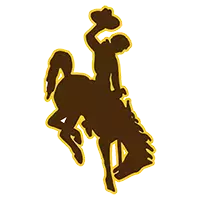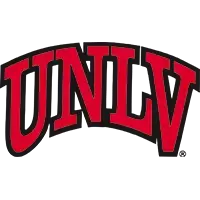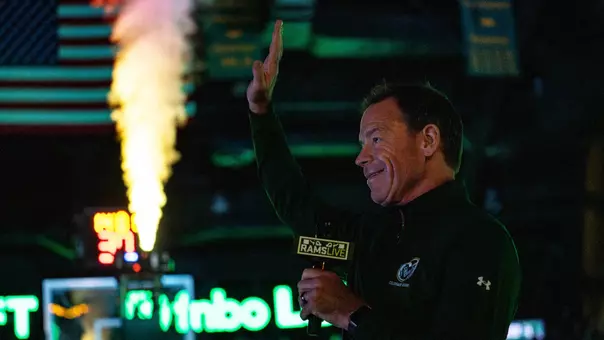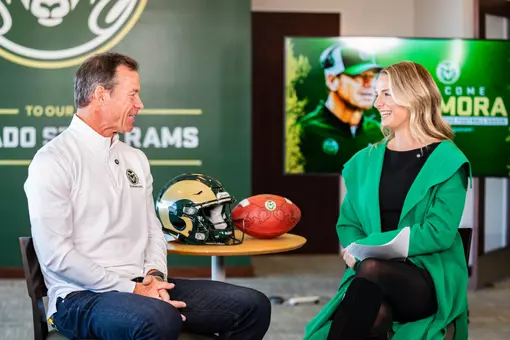Colorado State University Athletics
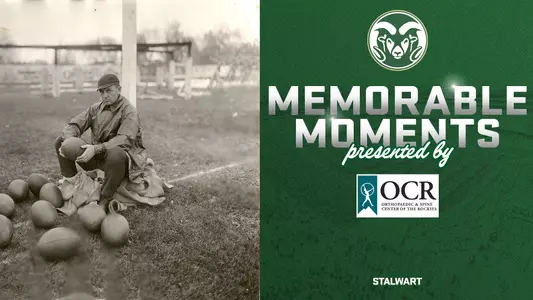
Memorable Moments: 130 Years of CSU Football, Part I
10/20/2022 2:00:00 PM | Football
Hughes earned the program national attention
It was 130 years ago that the first football team in school history was founded by students who wanted to play this new and popular game in Colorado. In part one of this two-part series, we look back on the Aggie era which can be defined as 1892 to 1956. From the humble student-led beginnings to the dominant Harry Hughes coaching era and first NFL quality players of the 1950s, football reigned as king in Fort Collins through most of this period.
The game of "foot-ball" as it was known in 1892, had begun to rise as a sport in Colorado as early as 1885 when Colorado College and the University of Denver played their first game. The Colorado School of Mines started play in 1888 and the University of Colorado in 1890. In 1892, students at Colorado Agricultural College formed a team in December and the first games were played in 1893, on a patch of ground off the campus but visible from Old Main because the college president wouldn't allow it on school grounds.
There is little to be excited about in those early days of football. President Ellis banned the sport from 1895-1898, eliminating much of that early history. In 1899, an athletic field was built and later named Durkee Field in 1901. It too was nothing exciting, a dirt patch of ground where the Glenn Morris Field House stands today with a wooden fence to keep freeloaders from watching games without paying.
Those first coaches were less than exciting as the team earned their first nickname, the Aggies in 1899 when coach William Forbes was hired for $25 a year to guide his team on the field. Forbes died in a freak accident in June of 1900 and the school's second coach, George Toomey took over. Toomey's reign was short because he resigned following a controversy over playing a student who had been paid as a professional at one time. There is little to mention about coaches Clarence Griffith, Matt Rothwell, John McIntosh, Claude Rothgeb and George Cassidy. The Aggies team was as unmentionable as their coaches in those days, and the game of football barely resembled the rules we know today.
The paradigm shift of football for the Colorado Aggies began when a 23-year-old Oklahoma graduate named Harry W. Hughes took over to begin a 31-year career which brought this small agricultural college in the national spotlight. Hughes had been an outstanding halfback at Oklahoma and assistant coach under the great Bennie Owen when he took the call to come to Fort Collins. While his 1911 team not only lost every game, but didn't even score one point all season, by 1915 he had built a machine nobody could match in the conference and national teams were afraid to play.
Led by halfback Ralph "Sag" Robinson, who had mastered Hughes' "Million Dollar Play", the Aggies went from perfect losers in 1911 to conference champions and perfect winners in 1915 with the school's only unbeaten, and untied season. Some fans 100 years later claim this team as national champions based on their points against competition ratio. Hughes' 1916 squad went 6-0-1, winning another championship, making for a two-year record of 13-0-1. Hughes continued to dominate the gridiron throughout the 1920s winning championships in 1919, 1920, 1925 and 1927. From 1919 to 1927, CAC Football went 51-15-5 (.753) and reached a national acclaim as one of the top 25 teams in the nation with their winning percentage.
Hughes was made a member of the NCAA National Rules Committee, a board member of the College Football Coaches Association and recognized locally as the dean of coaches. By 1935, the Aggies won two more titles in 1933 and 1934 and Hughes was recognized nationally for his tenure at one school longer than any other coach in the country. The Million Dollar days of the Hughes era ended in 1941 with the onset of WWII as men marched off to Europe and the Pacific, but not before Hughes broke the color barrier in local football by playing CSU legend John Mosley in 1940, 15 years before other Colorado universities played a black football athlete.
Hughes was known as a tough but fair coach by his players. Norm Cable (1935-1937) who replaced the great Glenn Morris at the end position, stated in a 1997 interview, "Coach Hughes was my salvation, and I will forever be grateful for the opportunity he gave me." Cable went on to say, "He was a builder of men and Colorado State University can be forever grateful and proud that he was a huge part in its development into the university it is today. The tradition is there for others to follow!"
Hughes was replaced by his protégé and long-time assistant Julius "Hans" Wagner in 1942, but WWII interrupted CSU football and there was no team fielded in 1943 and 1944. When the men came back from the war, it was hectic at first and Wagner was, as Don "Tuffy" Mullison said, "Dealt a losing hand by the administration and forced to resign in 1946."
In 1947, Bob Davis, a former Utah quarterback and assistant under Ike Armstrong took the reigns at Colorado A&M College and made war veterans into football stars. With men like Eddie Hanna, Jack Christiansen, Tuffy Mullison, Dale Dodrill, Joe Folsom and the legendary Thurman "Fum" McGraw, Davis guided his 1948 team to the first bowl game in school history. Davis, known by his players as "The Whip" because of his intense practice regimen, brought back Aggies football to the glory days again. (The name Rams was adopted in 1945 by students, but many alumni, administrators and fans struggled with the new nickname and mascot into the 1960s.)
Bob Davis was a no-nonsense coach who as 94-year-old Frank Faucett, a halfback on the Raisin Bowl team stated from his seats in Canvas Stadium in 2022, "He would make you practice on a Sunday even though the team had barley won a game the night before, because he wanted to work through problems while they were fresh in their heads."
Davis' last team won his only conference championship in 1955, thanks in part to All-American Gary Glick, who was chosen as the No. 1 pick in the 1956 NFL draft. It was said that at one time in the 1950s, there were more Colorado A&M alumni in the NFL than there were alumni from Notre Dame. Whether that is true or not, Davis, who was also a part-time NFL scout, had men like McGraw, Jim David, Gary and Freddy Glick, Don Burroughs, Harvey Achziger and pro football Hall of Famer Christian in the NFL to name a few.
The Aggie era ended in 1956, with Davis stepping down to concentrate on his athletic director duties which he had held since Hughes' retirement in 1953. Don "Tuffy" Mullison set out to rebuild a program left with no money and a dilapidated stadium.
The game of "foot-ball" as it was known in 1892, had begun to rise as a sport in Colorado as early as 1885 when Colorado College and the University of Denver played their first game. The Colorado School of Mines started play in 1888 and the University of Colorado in 1890. In 1892, students at Colorado Agricultural College formed a team in December and the first games were played in 1893, on a patch of ground off the campus but visible from Old Main because the college president wouldn't allow it on school grounds.
There is little to be excited about in those early days of football. President Ellis banned the sport from 1895-1898, eliminating much of that early history. In 1899, an athletic field was built and later named Durkee Field in 1901. It too was nothing exciting, a dirt patch of ground where the Glenn Morris Field House stands today with a wooden fence to keep freeloaders from watching games without paying.
Those first coaches were less than exciting as the team earned their first nickname, the Aggies in 1899 when coach William Forbes was hired for $25 a year to guide his team on the field. Forbes died in a freak accident in June of 1900 and the school's second coach, George Toomey took over. Toomey's reign was short because he resigned following a controversy over playing a student who had been paid as a professional at one time. There is little to mention about coaches Clarence Griffith, Matt Rothwell, John McIntosh, Claude Rothgeb and George Cassidy. The Aggies team was as unmentionable as their coaches in those days, and the game of football barely resembled the rules we know today.
The paradigm shift of football for the Colorado Aggies began when a 23-year-old Oklahoma graduate named Harry W. Hughes took over to begin a 31-year career which brought this small agricultural college in the national spotlight. Hughes had been an outstanding halfback at Oklahoma and assistant coach under the great Bennie Owen when he took the call to come to Fort Collins. While his 1911 team not only lost every game, but didn't even score one point all season, by 1915 he had built a machine nobody could match in the conference and national teams were afraid to play.
Led by halfback Ralph "Sag" Robinson, who had mastered Hughes' "Million Dollar Play", the Aggies went from perfect losers in 1911 to conference champions and perfect winners in 1915 with the school's only unbeaten, and untied season. Some fans 100 years later claim this team as national champions based on their points against competition ratio. Hughes' 1916 squad went 6-0-1, winning another championship, making for a two-year record of 13-0-1. Hughes continued to dominate the gridiron throughout the 1920s winning championships in 1919, 1920, 1925 and 1927. From 1919 to 1927, CAC Football went 51-15-5 (.753) and reached a national acclaim as one of the top 25 teams in the nation with their winning percentage.
Hughes was made a member of the NCAA National Rules Committee, a board member of the College Football Coaches Association and recognized locally as the dean of coaches. By 1935, the Aggies won two more titles in 1933 and 1934 and Hughes was recognized nationally for his tenure at one school longer than any other coach in the country. The Million Dollar days of the Hughes era ended in 1941 with the onset of WWII as men marched off to Europe and the Pacific, but not before Hughes broke the color barrier in local football by playing CSU legend John Mosley in 1940, 15 years before other Colorado universities played a black football athlete.
Hughes was known as a tough but fair coach by his players. Norm Cable (1935-1937) who replaced the great Glenn Morris at the end position, stated in a 1997 interview, "Coach Hughes was my salvation, and I will forever be grateful for the opportunity he gave me." Cable went on to say, "He was a builder of men and Colorado State University can be forever grateful and proud that he was a huge part in its development into the university it is today. The tradition is there for others to follow!"
Hughes was replaced by his protégé and long-time assistant Julius "Hans" Wagner in 1942, but WWII interrupted CSU football and there was no team fielded in 1943 and 1944. When the men came back from the war, it was hectic at first and Wagner was, as Don "Tuffy" Mullison said, "Dealt a losing hand by the administration and forced to resign in 1946."
In 1947, Bob Davis, a former Utah quarterback and assistant under Ike Armstrong took the reigns at Colorado A&M College and made war veterans into football stars. With men like Eddie Hanna, Jack Christiansen, Tuffy Mullison, Dale Dodrill, Joe Folsom and the legendary Thurman "Fum" McGraw, Davis guided his 1948 team to the first bowl game in school history. Davis, known by his players as "The Whip" because of his intense practice regimen, brought back Aggies football to the glory days again. (The name Rams was adopted in 1945 by students, but many alumni, administrators and fans struggled with the new nickname and mascot into the 1960s.)
Bob Davis was a no-nonsense coach who as 94-year-old Frank Faucett, a halfback on the Raisin Bowl team stated from his seats in Canvas Stadium in 2022, "He would make you practice on a Sunday even though the team had barley won a game the night before, because he wanted to work through problems while they were fresh in their heads."
Davis' last team won his only conference championship in 1955, thanks in part to All-American Gary Glick, who was chosen as the No. 1 pick in the 1956 NFL draft. It was said that at one time in the 1950s, there were more Colorado A&M alumni in the NFL than there were alumni from Notre Dame. Whether that is true or not, Davis, who was also a part-time NFL scout, had men like McGraw, Jim David, Gary and Freddy Glick, Don Burroughs, Harvey Achziger and pro football Hall of Famer Christian in the NFL to name a few.
The Aggie era ended in 1956, with Davis stepping down to concentrate on his athletic director duties which he had held since Hughes' retirement in 1953. Don "Tuffy" Mullison set out to rebuild a program left with no money and a dilapidated stadium.
Colorado State Football: Jim Mora Press Conference
Saturday, December 06
Rams Live Exclusive: Head Coach Jim Mora
Tuesday, December 02
Colorado State Football: Jim Mora Introductory Press Conference
Monday, December 01
Colorado State Football: Long (L) and Beers (R) Post-Game (Air Force, 2025)
Friday, November 28

